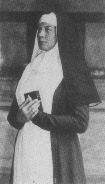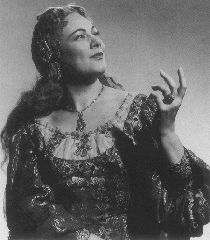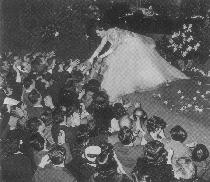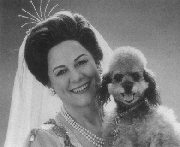

Dedicated to the great Italian soprano Renata Tebaldi
![]()


![]()
Throughout the 1950s and 60s, Renata Tebaldi graced the stages of the world’s most prestigious opera houses: La Scala, Covent Garden, Vienna; but her enduring home was the Metropolitan in New York, where she sang to loving audiences for almost 20 years. And there she sang the great roles of the Italian Fach repertoire to which, with very few exceptions, she remained faithful throughout her life. Her large, spinto voice, projected and placed with magnificent skill, was put to the service of all the great roles around which she built her repertoire. Sir Rudolf Bing, former General Manager of the Met, is one of those who can tell a tale or two about her determined, iron resistance to all attempts at luring her into a different repertoire or modern production. Bing recalled many amusing anecdotes of occasions on which his efforts to obtain her cooperation were met initially with a smiling “Sì”; but come opening night, she would perform the role exactly as she had in the past!
 THE BEGINNING
THE BEGINNING
Tebaldi’s great roles at the Met included Adriana Lecouvreur, Manon Lescaut, Mimì, Tosca, Minnie, and many others. But if Tebaldi—who was born Renata Ersilia Clotilde Tebaldi in Pesaro in 1922—were to be judged solely on that repertoire, one would never guess that at the beginning of her career, under the tutelage of the great Carmen Melis, she appeared in much lighter parts than those of her hey-day at the Met. Her professional debut was in Rovigo, Italy in 1944, as Elena in Boito’s Mefistofele—followed by performances in Parma and Venice. After a hiatus due to the war, Toscanini heard her in 1946 and immediately engaged her at La Scala for the soprano solo at a concert celebrating the reopening of the war-damaged house. It was a sensation! Legend held that Toscanini referred to her as having “the voice of an angel”; but with typical modesty Tebaldi would always set the record straight: apparently he said that he was looking for an angelic voice, and that she came closest to fulfilling his hopes.
 THE EARLY YEARS
THE EARLY YEARS
Renata Tebaldi’s first recordings indicate the wide scope of her early repertoire, which she later reduced to concentrate on the Fach. She had a marvelous bel canto, which she displayed in such operas as Rossini’s William Tell (1952), Moses in Egypt, and The Siege of Corinth (1946); Spontini’s Olimpia (1950), Fernando Cortez (1951), and Agnese di Hohenstaufen (1954); and Handel’s Giulio Cesare (1950). She also sang the earlier roles of Verdi (Joan of Arc) and even some Mozart. One might have guessed that she was headed for a great career in this repertoire; but even then she was attracted to heavier roles, even going so far as performances (in Italian) of Wagner’s Tannhäuser (under Karl Böhm in 1950) and Lohengrin. And while she might have gone on to sing Senta, Agathe, or even Isolde, she instead forayed into the French repertoire (again, in Italian) with Gounod’s Marguerite (Faust).
 THE RIVALRY WITH CALLAS
THE RIVALRY WITH CALLAS
1955 was a critical year for Tebaldi. She’d become one of La Scala’s leading singers, and had given many memorable performances in houses throughout Europe and America. Tebaldi began to restrict her roles at La Scala to a core repertoire, singing a great many Aïdas, Desdemonas (Otello), and Madeleines (Andrea Chénier). At the same time, the great Maria Callas rose to some prominence at the house, where her dealings with the management were always painful. A great rivalry broke out; not so much between the singers themselves as between their fans and supporters in the press. But incidences like Callas’ remark that to compare her voice to Tebaldi’s was like comparing “champagne to Coca-Cola” eventually impelled Tebaldi to accept Rudolf Bing’s invitation to the Met.
 TO THE MET
TO THE MET
For eighteen years Tebaldi was the unquestioned prima donna of the Met, from her house debut as Desdemona in 1955 through her last performance in the same role in 1973. Two qualities characterized Tebaldi’s singing: the ability to pace herself, and the remarkable evenness of her register. In addition to her flawless diction and intonation, her voice had an immensely recognizable dramatic intensity; she was a great singer, and she was a great actress. But she shared a certain aloofness in her performance with most of the other sopranos of her time, among whom a strongly dramatic singer like Callas was the rare exception. The voices of singers who share Tebaldi’s repertoire tend to acquire a certain shrillness in their upper registers, overtaxed by too many big parts taken on too soon, leaving a frayed voice around a solid core. But Tebaldi always chose to hold back rather than to exceed her capabilities, and this careful calculation led to her lasting quality as one of the greatest singers of our time. We can still see from recordings the high degree of subtlety and dramatic expression she achieved, communicated by an evenly flowing soprano voice with a remarkable legato line.
 LEGACY
LEGACY
Tebaldi made no conscious desion to retire; fulfulled with her career, she simply stopped accepting new engagements. She gave her last full opera performances (as Desdemona) at the Met in 1973, and her last recital was at La Scala in 1976. In 1974 she closed her apartment in New York to return to her native Italy. Today she lives in Milan and takes her holidays in San Marino—all with her beloved poodle, New Second (so called because she purchased her predecessor, New First, in New Jersey). Among the many honors she's received are the highest awards of the Italian, French, and Japanese governments; honorary doctorates; and in 1986 she received a rather unique honor when a new breed of rose was named The Tebaldi. But perhaps the most moving tribute came in 1996, when Tebaldi returned to the US for the first time in twenty years. The occasion was the publication of her biography, and she appeared for a book signing in the gift shop of the Metropolitan Opera. Despite the frigid, winter day, the turnout was astounding: the line of admirers went out of the shop, through the Met's lobby, across the plaza at Lincoln Center, down several blocks of Broadway and into a subway station. They ran out of books within an hour, and fans received her autograph on whatever scraps of paper they could find. Indeed, the unforced silken beauty and natural, lyrical expression of her voice had transcended the passage of time—as has the undying love of her new and original devotees.
LA TEBALDI: Links on this site
 ONE FAN’S TWO CENTS Or, "Why I love Renata Tebaldi".
ONE FAN’S TWO CENTS Or, "Why I love Renata Tebaldi".
 REPERTORY A list of the complete operatic roles Tebaldi sang in the course of her career.
REPERTORY A list of the complete operatic roles Tebaldi sang in the course of her career.
 DISCOGRAPHY Recommended recordings of La Tebaldi.
DISCOGRAPHY Recommended recordings of La Tebaldi.
 OperaWeb Information on Tebaldi—and others!
OperaWeb Information on Tebaldi—and others!
 THE METROPOLITAN OPERA Though Tebaldi is no longer there, her legacy lives on in the Met's commitment to excellence.
THE METROPOLITAN OPERA Though Tebaldi is no longer there, her legacy lives on in the Met's commitment to excellence.
![]()